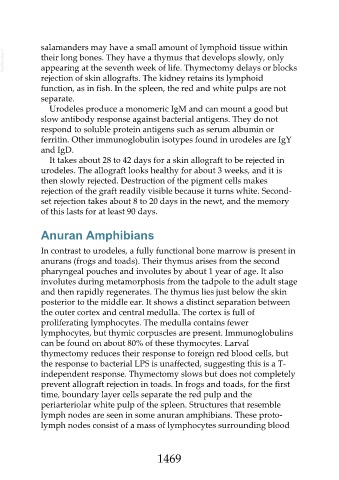Page 1469 - Veterinary Immunology, 10th Edition
P. 1469
salamanders may have a small amount of lymphoid tissue within
VetBooks.ir their long bones. They have a thymus that develops slowly, only
appearing at the seventh week of life. Thymectomy delays or blocks
rejection of skin allografts. The kidney retains its lymphoid
function, as in fish. In the spleen, the red and white pulps are not
separate.
Urodeles produce a monomeric IgM and can mount a good but
slow antibody response against bacterial antigens. They do not
respond to soluble protein antigens such as serum albumin or
ferritin. Other immunoglobulin isotypes found in urodeles are IgY
and IgD.
It takes about 28 to 42 days for a skin allograft to be rejected in
urodeles. The allograft looks healthy for about 3 weeks, and it is
then slowly rejected. Destruction of the pigment cells makes
rejection of the graft readily visible because it turns white. Second-
set rejection takes about 8 to 20 days in the newt, and the memory
of this lasts for at least 90 days.
Anuran Amphibians
In contrast to urodeles, a fully functional bone marrow is present in
anurans (frogs and toads). Their thymus arises from the second
pharyngeal pouches and involutes by about 1 year of age. It also
involutes during metamorphosis from the tadpole to the adult stage
and then rapidly regenerates. The thymus lies just below the skin
posterior to the middle ear. It shows a distinct separation between
the outer cortex and central medulla. The cortex is full of
proliferating lymphocytes. The medulla contains fewer
lymphocytes, but thymic corpuscles are present. Immunoglobulins
can be found on about 80% of these thymocytes. Larval
thymectomy reduces their response to foreign red blood cells, but
the response to bacterial LPS is unaffected, suggesting this is a T-
independent response. Thymectomy slows but does not completely
prevent allograft rejection in toads. In frogs and toads, for the first
time, boundary layer cells separate the red pulp and the
periarteriolar white pulp of the spleen. Structures that resemble
lymph nodes are seen in some anuran amphibians. These proto-
lymph nodes consist of a mass of lymphocytes surrounding blood
1469

